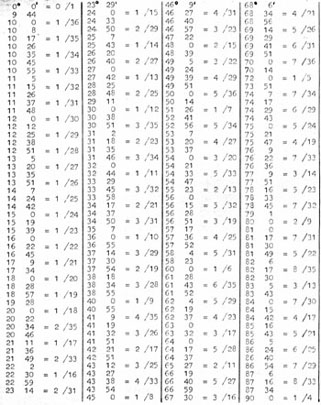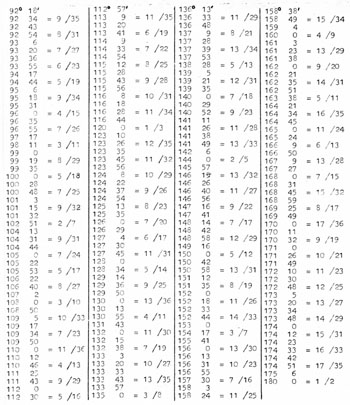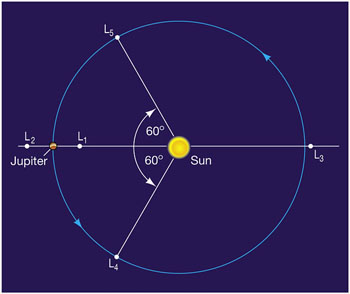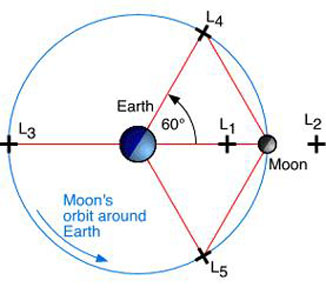|
It
may be that where aspects and orbs are concerned, the meek may inherit
the sky.
...The
Taming Power
Of The Small
All
astrologers are
familiar with the traditional
Ptolomaic aspects (conjunction, sextile, square, trine, opposition) and
usually
the more recently-used semi-sextile and quincunx. These
are all based on dividing the circle into multiples of two
and three, to a total of twelve. Multiples of two are hard aspects,
multiples
of three, easy ones.
They are probably
the most popular because they are the easiest to spot using the common
1-30
degree per sign labeling system. But there are also aspects which come
from
dividing the circle into 5ths, 7ths, 9ths, 11ths, and 13ths, often
called
“harmonic” aspects because of John
Addey’s
pioneering work on harmonic charts during the
1970’s which brought
these aspects into greater usage. Exactly
what they mean and how important they are is
still a matter to
be decided even among those who use them regularly, so here is a
personal
approach, based on the theory and structure of the number combinations
involved, and sustained by observation in practice (anecdotal evidence,
as some
might call experience).
The 5th
part of the circle (quintile): 72°, 144°.
This is
an aspect with
some age and tradition behind it,
having been used for quite a while. It
is generally associated with natural “talent,”
though of
what kind is not always
made clear.
In fact, it has
to do with
the ability to spot and untilize proportion in either time or space or
both.
Frequent in the
charts of
musicians, artists, architects, orators, and others who depend on a
good sense
of timing or proportion for success. This
can be for good or ill, as for instance the
chart of Hitler is
riddled with 5ths and their halves, 10ths -- certainly he was the most
talented
and compelling orator of the 20th century, and the timing of his
decisions was
impeccable, despite the way he used it. This
quality is likely derived from mathematical
applications of the
number five itself, from which the Golden
Section
(phi),
is derived.
Its
formula is:
φ
=
[√5-1]/2, or 0.6180359...or, magically, φ
=
[1+√5]/2, or 1.6180359...
and it
is the universal
proportion of growth within the
biological kingdom.
It’s
the
proportion
of your elbow to your overall arm, your naval to your whole frame,
seashell and
pinecone spiral length and count from level to level, leaf positioning
in
vines, and so on.
It is much used
in
all forms of art in architecture, since those are at least in part
imitations
of life.
The 7th
part of the circle (septile): 51°26’,
102°51’.
This
aspect is not so
much in use, though it has had some
popularity.
It appears to
represent a
kind of large-scale, universal outlook on the applications of the
planets so
attached.
It is an ability
(indeed, an
insistence), to see the Big Picture instead of getting hung up in the
details
or in only one part of the story. This
has a lot of mythological background, as in most Western and much
Eastern
scripture and secular beliefs, the number seven is associated with
completion:
the seven days of creation (and thus, the days of the week), the seven
heavens,
seven archangels, seven pillars of wisdom, seven colors of the rainbow,
seven
visible planets, seven chakras, seven deadly sins, etc. Even the
maximum number
of ideas that can be simultaneously held
in the brain.
It
does indeed seem
to lend a broad scope of vision in the planetary areas involved in any
given
horoscope.
The 9th
part of the circle (nonile): 40°, 80°, 160° (120°
coincides with
trine). This aspect is fundamental in Hindu astrology, but peripheral
in the
West.
It is, in my
experience, the
ultimate “nice person” aspect, of which the
quintessential
bleeding heart
liberal must be entirely constructed. It
indicates sympathy, generosity, humanitarianism,
and general good
will, although it is does not always translate this into assertive
action.
You want friends? Get
some of these...
The
11th
part of the circle: 32°44’, 65°27’,
98°11’, 130°55’,
163°38’. This
is a really rough aspect, and wholly
unused among traditional astrologers. There
is a lot of Biblical symbolism concerning the
number 11 itself,
and all of it is has to do with insufficiency, frustration, and
incompletion, a
situation that just falls short of the more whole and complete number
12.
It also seems to
be a somewhat
revolutionary
number, as it expresses dissatisfaction with the status quo and fuels a
need to
overthrow it.
Oddly, in
numerology it
is called the number of the World Savior, but that may also have
overtones of
overthrow.
Remember what
Christ did to
the money-changers and you may get a hint. Also
His statement, “Think not that I came to
send peace on earth:
I came not to
send
peace but a sword.
For I am come to
set a
man at variance with
his father, and the daughter against her mother, and the
daughter-in-law
against her mother-in-law.” (Matthew 10:34-35).
Troublesome
stuff – that’s OK if
you’re the Son of God, but hard
to handle as a mere mortal.
The
Ayatollah Khomeini’s chart was loaded with it...
The
13th
part of the circle: 27°42’. 55°23’,
83°05’, 110°46’,
138°28’,
166°09’.
This is
one step beyond
the natural twelve, and folks with
a lot of this tend to be one step beyond, indeed. It
is an aspect of the eccentric, the adventurer, the person who
decides to travel the road less taken or forge out into the woods when
the road
ends.
Sexually, it can
be rather kinky
(until, of course, kinks become mainstream, and thus boring), and it
may lead
to great adventure or simply to a useless backwater or cul-de-sac. Some
paths are less-traveled for good
reason...but there is always interest and amusement here, if nothing
else,
though those traveling in pastures beyond the pale should take
appropriate
cautions concerning both the perils of the unknown and those who
don’t feel
comfortable with the unusual.
Although
these are the
main extra fractions of the circle
I use for aspects, it would seem logical to use more, for structural
reasons.
Although many of
the higher,
finer aspects are mutual multiples of larger ones (deciles, for
instance, being
half of quintiles), there are still some prime numbers to be reckoned
with,
such as 17, 19, 23, 29, 31, and so on. I
have found 17 and 19 to be sort of “upper
octaves” of 11 and 13, or at
least similar in some ways.
For the
rest, seek out Addey’s work for clues.
Orbs. The
question of orbs for these aspects arises, part of an enduring subject
of
debate about all aspects among all astrologers, which opens another
structural
problem, but one which is actually easily solved. If,
for instance, we use all fractions of the circle up to the
36th (ten degrees), and we make the orb for any two adjacent aspects
inversely
proportional to their denominators, we come up with virtually the
normal set of
orbs for the traditional aspects most astrologers use -- a little under
ten degrees max for an important conjunction, , five or six degrees for
an opposition, three or four degrees for
a trine or square.
But, using the
same
formula, some of the
finer aspects get wider orbs than usually in use. A
quintile gets 2°, more than a quincunx is entitled to (about
3/4°), a
septile gets a full
1 1/4°,
and so on.
Even the unknown
11th is
entitled to more space than a semi-sextile or quincunx.
It
would appear that perhaps these somewhat
neglected
aspects are more important than they have been given credit for, as we
make the
attempt to base our practical usage of astrology on a more
mathematically consistent substrate.
 
The
table above lists
all the fractions of the
circle (2-36), with orb limits assigned according to the size of their
denominators (inversely, the smaller the fraction, the smaller the
space it
takes up compared with its neighbor), and it’s interesting to
see
the patterns
they form around the major aspects. Even though we only go up to
the 36th
harmonic here, it’s clear that around the conjunction,
opposition, square, and
trine there is a space of infinitely reducing fractional aspects until
the
perfect aspect is formed, almost a gravitational or mathematical swath
around the
aspects, according to their size. The little entries really do bow down
to the
big ones, so it’s no wonder we favor the traditional aspects.
But
perhaps we should pay more attention to the real relative mathematics
of nature and take a closer look at what we have chosen to ignore
through the visual inconvenience of our common 1-30°
method
of chart layout.
Lagrange
Points.
Indeed, that image and model may have more to be said
for it, as these same major divisions of the circle in any
planet’s orbit
describe its Lagrange
points,
the attractively stable areas where other, smaller
objects tend
to cluster and be ushered along, like many of the
“Trojan”
asteroids with
Jupiter, many of the Centaurs with Neptune. Perhaps the very nature of
aspects
itself is gravitational, as we are inclined to believe. The bigger the
object
and the longer the time it’s been there, the more perfectly
aligned everything
else becomes to it, part of the phenomenon of entrainment. How far that
goes
down the decreasing scale of existence, right to our own actions here
on earth,
is one of the most important astrological questions to be addressed.
--- John Townley
  Lagrange
points: Gravitationally,
aspects based on
three are stable, others not...is that
where astrology gets it
from?... to play with where these points occur throughout the solar
system, plus more nice illustrations, and simple math, go
here... Lagrange
points: Gravitationally,
aspects based on
three are stable, others not...is that
where astrology gets it
from?... to play with where these points occur throughout the solar
system, plus more nice illustrations, and simple math, go
here...
Not
a
newsletter subscriber already? Subscribe
Free Here!
--
Breaking news from
around the globe, plus articles, reviews, it's all happening there,
changes daily...
|

